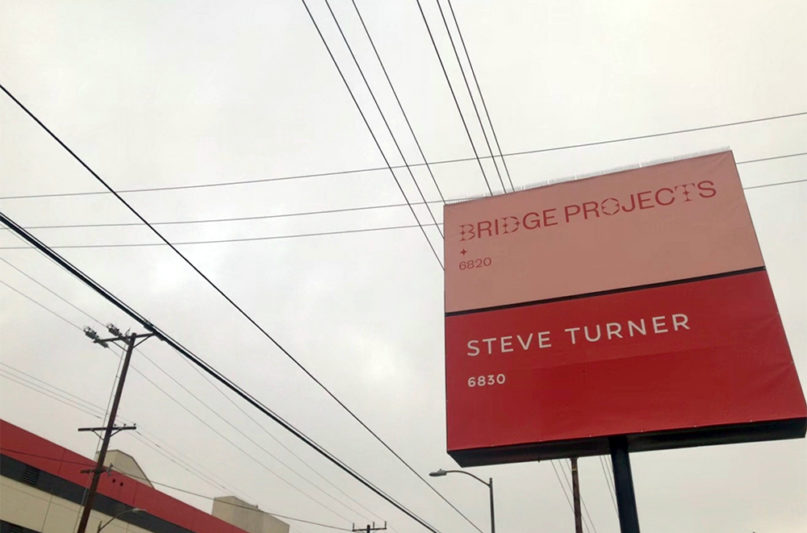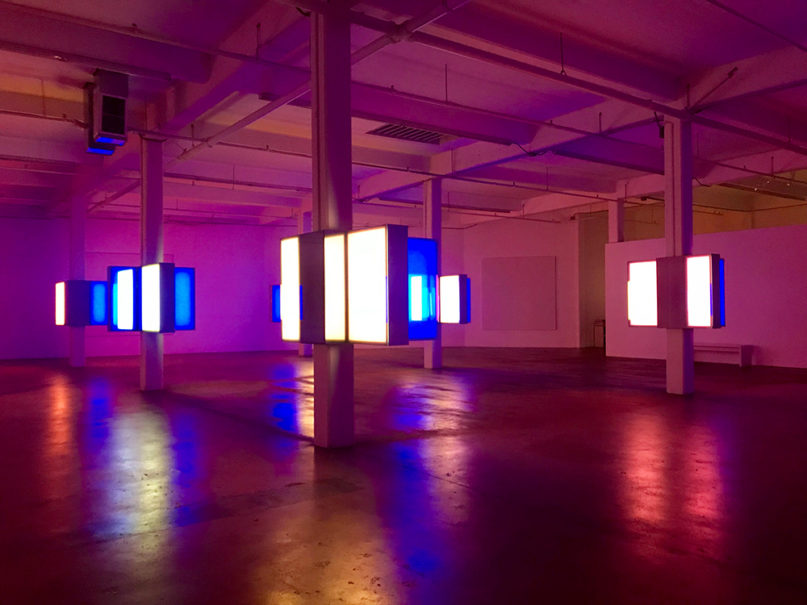LOS ANGELES (RNS) — For Linnéa Spransy, who grew up in a Christian commune in Oregon with a rock musician father, religion and art have always been intertwined.
“Religious lifestyle, and expression and art were all the same thing,” Spransy told Religion News Service.
Spransy is one of the directors of Bridge Projects, a new Southern California gallery that seeks to link art with spiritual and religious traditions.
The gallery’s inaugural exhibition, “10 Columns” by artist Phillip K. Smith III, features glowing mirrored panels that convert the otherwise dark room into a simulated sunrise and sunset. The panels shift colors, from warm yellow and orange tones to bright blue and red hues.
The exhibit opened in October in Bridge Project’s 7,000-square-foot gallery, which sits between a Mobil gas station and a Public Storage facility on Santa Monica Boulevard. Visitors to the gallery have described their experiences in the space on Instagram, calling the installation “enthralling” and saying it made them feel “reflective” and “meditative.”
https://www.instagram.com/p/B4jmSVPDpl0/
“Is one witnessing a sunrise or a sunset, a cultural awakening or a catastrophic meltdown?” wrote Julia Ingalls in The Architect’s Newspaper.
Bridge Projects directors Spransy and Cara Megan Lewis, who are both artists, said they wanted to create a space where people can talk about spiritual and religious perspectives.
The two have known each other for about a decade and both have roots in Kansas, where Lewis had a gallery space.
Lewis, whose background is in commercial galleries, said she’s seen how artists have felt the need to “suppress their faith traditions or religious convictions in the context of the contemporary art world.”
“Just a fear of rejection and misunderstanding,” she said.
Lewis, who grew up in the Methodist church, said she was raised with a faith-driven and social justice mindset that has influenced her own art. She was part of an interactive artwork, dubbed “34,000 Pillows,” that drew attention to a congressional rule that required the U.S. Immigration and Customs Enforcement to maintain 34,000 beds in its facilities.

Signage for Bridge Projects on Santa Monica Boulevard in Hollywood. RNS photo by Alejandra Molina
Bridge Projects was funded by Roberta Ahmanson, who along with her husband, Howard Ahmanson, was in 2005 named as one of Time magazine’s “25 Most Influential Evangelicals in America.” Spransy said Roberta Ahmanson began collecting her work when Spransy was still in Kansas City.
The Ahmansons have a track record of funding cultural endeavors, spanning back to the late Howard Ahmanson Sr., whose family name is on the Ahmanson Theatre in LA.
Through the private philanthropy Fieldstead and Co., Ahmanson and her husband have sponsored a number of art exhibitions in the United States and Great Britain along with journalism about the arts and religion. Fieldstead and Co. also funded support of California’s Proposition 8, a same-sex marriage ban that passed but that was later ruled unconstitutional by a federal judge.
Roberta Ahmanson, a former newspaper reporter and editor who covered religion in Southern California, said that in order to understand human beings, you need to understand their beliefs.
“You need to be able to talk about it in the art world because it’s there,” Ahmanson added. “It was just a subject you couldn’t talk about.”
With the “10 Columns” exhibition, which continues through Feb. 16, Bridge Projects has hosted programming that relates to “the subject matter of light from diverse sources.”
https://www.instagram.com/p/B32Jan7hz_-/
In November, anthropologist Ronald Faulseit lectured about the role natural light played in influencing ancient temples, ritual and religion in Mesoamerica. Earlier this month, artist Lita Albuquerque spoke about her work and the intersections of light, landscape and scientific cosmologies.
Spransy is pleased to see people being open to this kind of programming.
“I was really encouraged and interested in how many people responded well when we talked about inviting archaeologists to come talk about Mesoamerican temple architecture and the fact that light orientation was so important to a lot of ancient cultures,” she said.
Spransy said that in her professional life, she’s been told that religion and art need to be “strained out from one another.”
She hopes the new gallery proves otherwise.
“I still believe it doesn’t have to be that way, and it shouldn’t,” she said.
(Editor’s note: Fieldstead and Co. has supported past RNS arts coverage through a grant to the Religion News Foundation.)





